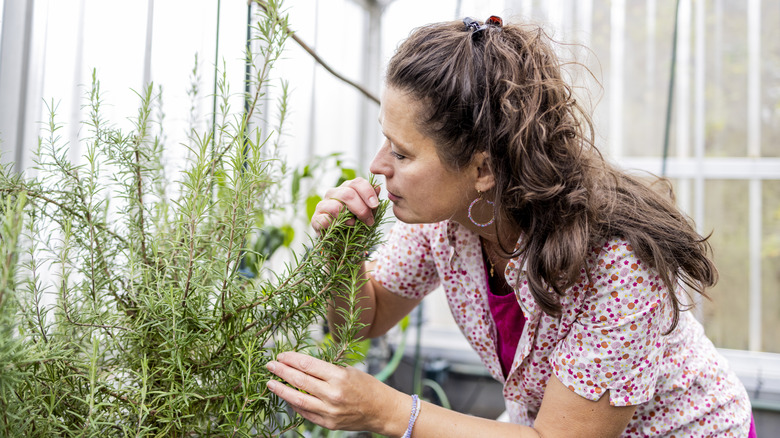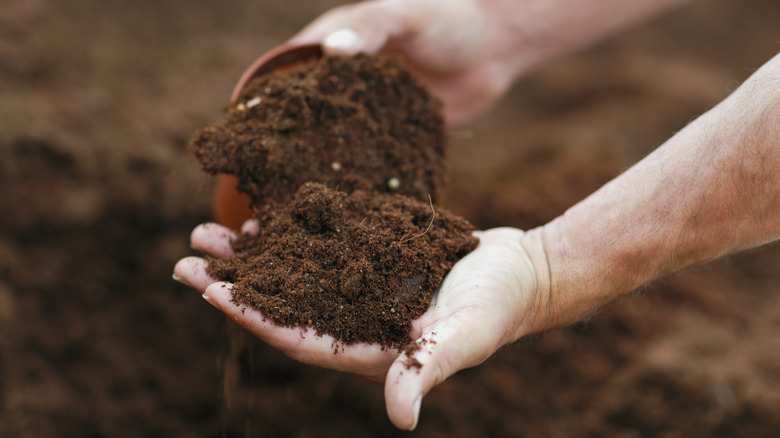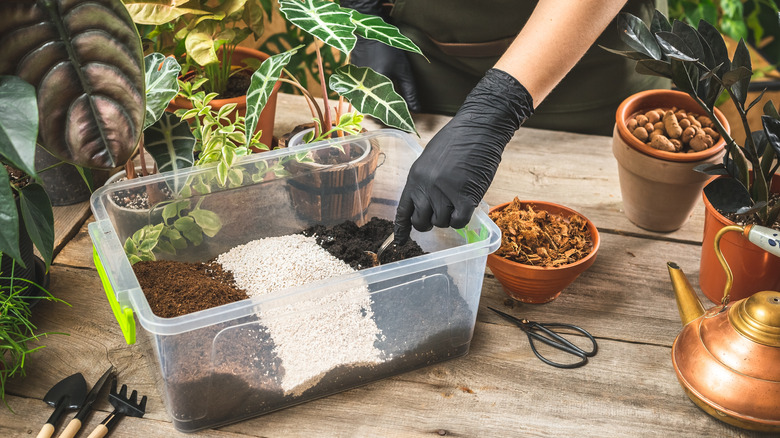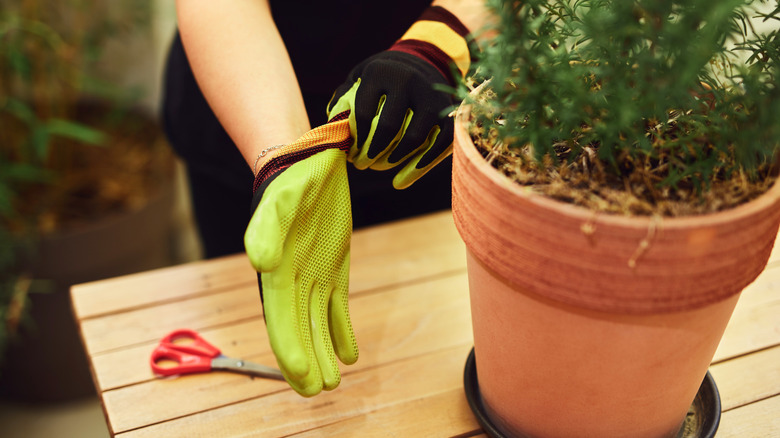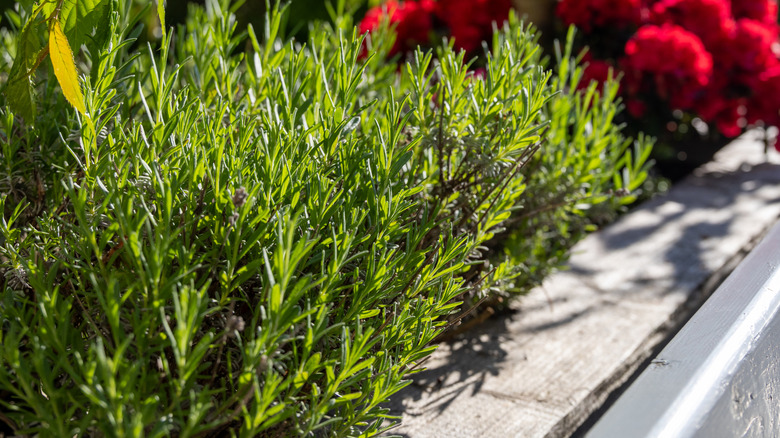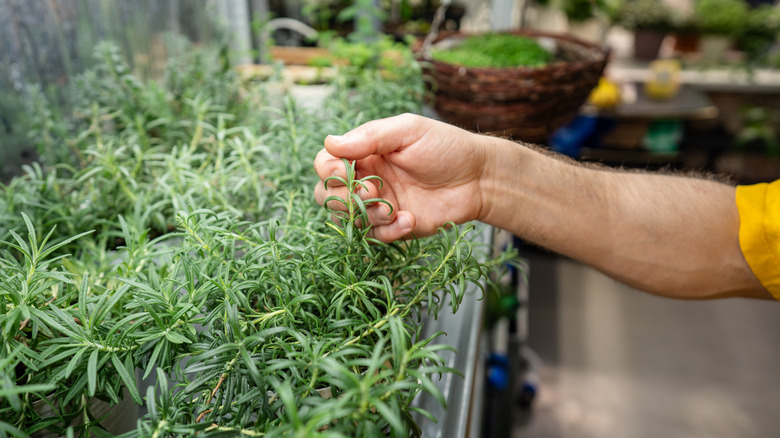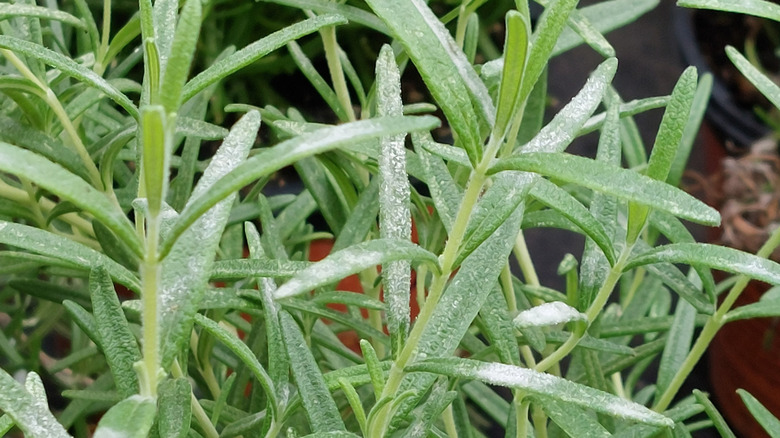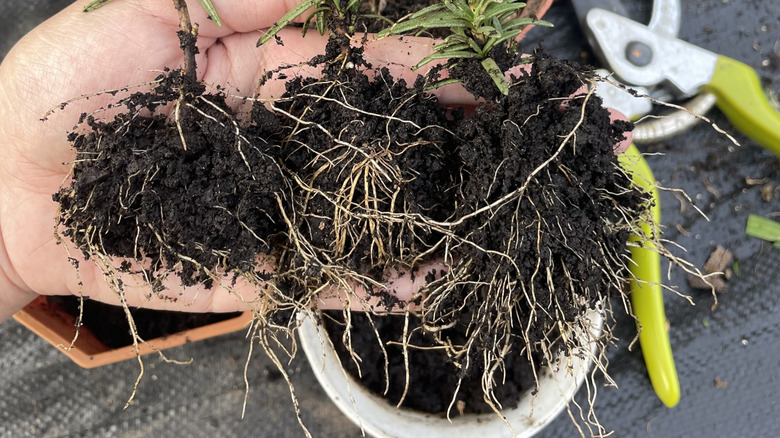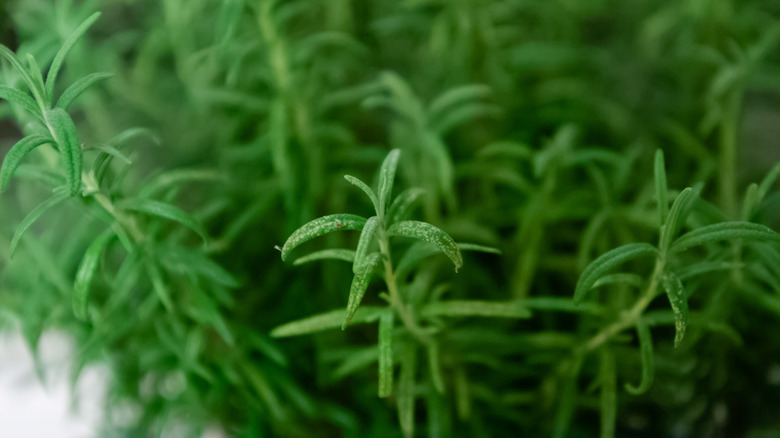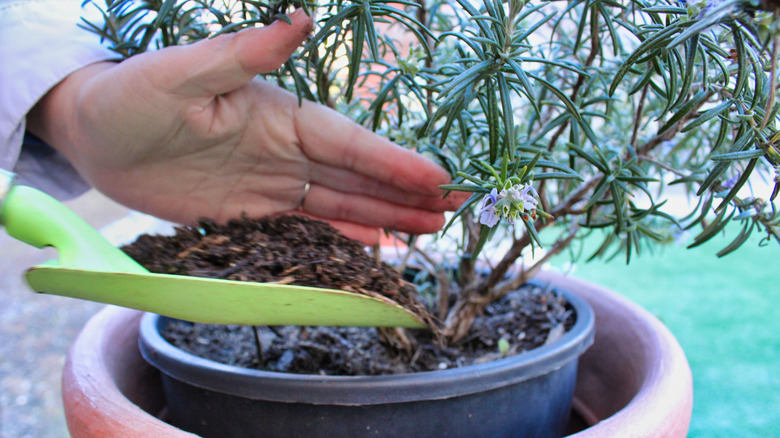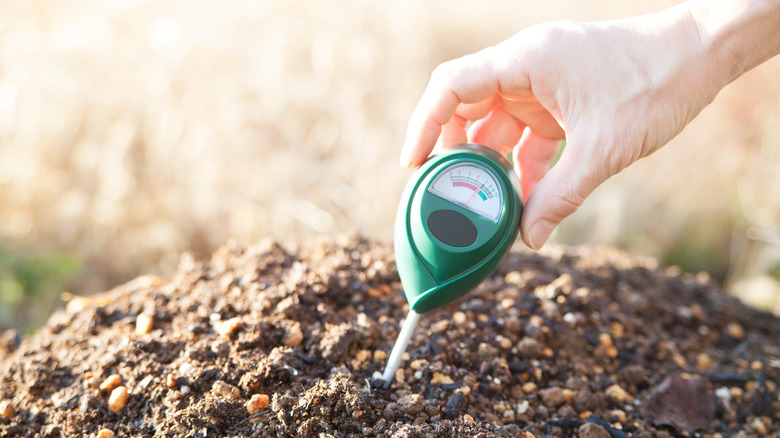10 Foolproof Ways To Bring Dying Rosemary Plants Back To Life
Rosemary (Salvia rosmarinus) is a choice herb, as it is not only beautiful to behold, but it also smells lovely and can give dishes an iconic flavor. But despite its reputation as tough and drought-tolerant, rosemary can be more particular than you'd think when conditions shift away from what it prefers. This is why knowing how to care for your rosemary plant is so important. A once-thriving herb can quickly show signs of distress, such as yellowing foliage, brown crispy leaves, or entire branches dying back. In many cases, these symptoms cause home gardeners to overcorrect by either watering too much, pruning too harshly, or fertilizing too heavily. These actions can actually worsen the plant's condition and lead to further decline.
The first step in reviving rosemary is to confirm what's actually wrong. Look closely at the leaves and stems for patterns and potential problems. For example, yellowing or dark brown tips often point to overwatering and root rot, while brittle, dry foliage usually means drought stress. If possible, you'll also want to unpot the plant and examine the roots. Healthy rosemary roots are firm and light-colored, while rotting ones will be dark in color, mushy, or foul-smelling. Once you've correctly identified the issue plaguing your rosemary plant, you can begin the foolproof process of successfully bringing the herb back to life.
Dry out overwatered soil before further damage occurs
Overwatering is a very common reason rosemary plants experience both decline and death. This is because rosemary is native to Mediterranean regions that tend to have well-drained conditions. Constantly wet roots from overwatering suffocate the plant and invite fungal diseases such as root rot, which often spreads quite rapidly. If you notice your rosemary suffering from overwatering, you'll need to take immediate action to dry out the soil and save the herb.
To implement this fix, stop watering the rosemary immediately. If it's in a pot, move the plant to a bright, airy spot. Use a small fan if necessary to increase air circulation. Raising the temperature a degree or two is also a great way to correct damage from overwatering, as the heat helps dry out the soil faster. If you have a hairdryer, that may also work as long as you stick with the low-heat setting. However, too much heat will scorch the herb. Once the soil has dried out, keep your rosemary plant thriving with this simple watering tip: Give it a drink only once every week or two, making sure the soil has dried out in between, and hold off on watering if it has rained and the soil is already saturated.
Increase drainage to fix compact soil
In addition to overwatering, your soil may be too compact, causing moisture to sit longer than it should. This creates conditions similar to overwatering, and also encourages the growth of fungal diseases, as well as the suffocation of the plant's roots. Amending the soil and increasing drainage by choosing the right flower pot is crucial for plant survival. Fortunately, this fix is easy and straightforward to implement and is budget-friendly in price.
Once you've figured out that improper drainage is the reason your rosemary is turning brown, you can take steps to improve it. Repotting it into a proper container and medium gives the plant a second chance by restoring airflow and preventing waterlogging. Start off by choosing a porous pot, such as one made from terracotta or clay, and make sure it is outfitted with drainage holes. Fill the pot with a fast-draining potting mix, such as one that contains perlite, pumice, and coarse sand, and then transplant the rosemary. When repotting, make sure you gently shake or wash off as much of the old, heavy soil as possible without tearing healthy roots. If your pot comes with a cachepot or saucer, make sure you discard any excess water that is being pooled within it.
Prune damaged rosemary to rejuvenate the plant
Dead or weakened growth drains energy from rosemary, leaving it vulnerable to decline. Pruning restores vigor by redirecting resources to healthy stems and encouraging fresh growth. However, cutting into old woody stems is usually futile as the plant cannot push new shoots from bare wood. Gardeners will want to reserve pruning for younger, thinner, and less woody stems that are showing signs of damage. This may include droopy stems or leaves that are browning at the tips.
Before you prune your rosemary, it is essential that you disinfect your pruning shears to avoid spreading disease. This can be done using either Lysol, chlorine bleach, or isopropyl alcohol. When pruning, don't remove more than one-third of the plant at a time. Make cuts just above a node where new growth can emerge. For younger, thinner stems showing tip dieback, simply snip off the dying portions. For older woody stems, wait to see whether they push out new growth in spring. If not, cut them back at the base. Save major shaping for spring when plants are actively growing. Heavy pruning in winter can further stress a struggling plant.
Expose the rosemary to more light
Rosemary that lacks its characteristically strong fragrance, shows signs of stunted growth, or features stems that have become tall, thin, and weak may not be getting enough light. Without at least 6 hours of direct sun, the plant cannot photosynthesize efficiently, leading to a weakening of its overall health. Indoor growers sometimes struggle with this, but supplemental lighting can solve the problem when direct light is lacking.
When it comes to plants that are perfect for south-facing windows, rosemary fits the bill. This herb will benefit from the longer duration of sunlight. If the simple solution of moving your plant to a south-facing window isn't possible, you can also expose your rosemary to more light via a fluorescent or LED grow light. Provide 14 to 16 hours of this artificial light daily, making sure to position the lamp 6 to 12 inches away from the plant. If the light is too close, it could scorch the rosemary's leaves. No matter the light source, occasionally rotate the pot to ensure even exposure.
Stabilize temperature and avoid drafts (especially indoors)
If you notice your rosemary begin to fade away during the winter months, temperature is typically the culprit. Rosemary is happiest in mild, Mediterranean-like conditions that include warm days, cooler nights, and steady air circulation. Through winter, the plant does best in bright light with cool days that fall between 60 and 65 degrees Fahrenheit and cooler nights that stay above 40 but below 50 degrees. Good air movement is also a necessity, as heated homes with stagnant air or sudden drafts can stress rosemary, making it decline even further. If left outdoors, sudden frosts may kill roots or branches outright. Maintaining stable conditions is needed to halt the decline before it's too late.
Before the first frost, bring outdoor rosemary indoors to protect it from freezing temperatures. Choose a spot for the plant that is a good distance from any heating vents, furnaces, fireplaces, or doors that lead to the outside. The room needs to experience a consistent temperature between 60 and 65 degrees, but keep in mind that the rosemary still needs adequate light. That means you'll need to set up artificial light if you relocate the plant to a garage.
Treat powdery mildew early
Powdery mildew is a common rosemary fungal disease that appears as white, powdery growth on the plant's leaves. Left untreated, it weakens the plant and can stunt growth. In severe cases, powdery mildew can even kill foliage. Fortunately, early intervention works well. Improving airflow, increasing light exposure, and applying safe treatments can stop the spread without harming the plant.
At the first signs of powdery mildew, remove heavily infected leaves and then relocate the rosemary plant to a spot with better airflow and more light. If symptoms persist, use remedies such as potassium bicarbonate, Bacillus subtilis products, or horticultural/botanical oils labeled for use with herbs. Always test sprays on a small section before covering the whole plant. Repeat applications as directed and combine them with environmental fixes for lasting success.
Act immediately when root rot is detected
Root rot, caused by pathogens like Phytophthora, is one of the most devastating threats to rosemary. The disease develops when roots are allowed to sit in soggy soil. Once roots turn soft and brown, the plant struggles to take up water or nutrients. Root rot is also quick to spread, which is why taking immediate action is so important. While you won't be able to save severe cases of root rot, you can revive a dying rosemary if you begin treatment as soon as you spot the disease.
Once you understand what root rot is, you can begin dealing with it. Start treatment by removing the plant from its pot and washing the soil away from the roots. Trim back all dark, mushy tissue, leaving only firm white roots. Repot into a clean container with fresh, well-draining soil. Discard the old soil and sanitize the pot to prevent reinfection, and water the plant sparingly until new growth appears.
Manage pests that sap a stressed plant
A weakened rosemary is more likely to suffer pest infestations, such as aphids. Aphids suck plant juices, causing spots, yellowing leaves, and general decline. Infested plants become weak and also lose resistance to disease. Tackling pests promptly using natural predators and organic insecticides prevents a stressed plant from suffering major damage that is harder to recover from.
Inspect leaf undersides with a magnifying glass for tiny moving dots or webbing. For mild infestations, rinse foliage under a gentle stream of water. This will dislodge the insects. You can also introduce parasitic wasps to your herb garden, as these tiny creatures will provide biological control, eliminating the need for chemical intervention. For more severe aphid infestations, use insecticidal soap or neem oil, applying thoroughly following the instructions on the product label. Make sure you don't apply the natural insecticide in direct sunlight, as this can lead to leaf burn. Repeat treatment weekly as needed, and always inspect the undersides of leaves regularly to catch new pests early.
Change your fertilization practices
It's tempting to reach for fertilizer when a plant looks weak, but rosemary isn't a heavy feeder. Excess nutrients can burn roots, scorch leaves, and upset soil balance. This makes the herb more susceptible to disease. Should you find your plant's decline is a result of too much fertilizer, you'll need to change your feeding practices. The best practice is to hold off until the plant shows signs of recovery, then supply only modest nutrients to support new shoots.
If your rosemary shows signs of overfertilization, flush the soil thoroughly with water to leach excess nutrients. Remove any scorched leaves and prune lightly to encourage recovery. Repotting may be necessary if salt buildup is severe. If future supplementation is needed, simply apply an all-purpose fertilizer each spring before the plant's active growth phase. Avoid fertilizing during winter dormancy or when the plant is stressed. In garden beds, compost-enriched soil is usually sufficient without extra feeding.
Correct soil pH to ensure the plant is getting the proper nutrients
Finally, to make sure a pH imbalance isn't standing in the way of your rosemary plant's recovery, test the soil it's growing in, as even if water, light, and care are correct, soil pH imbalances can also prevent rosemary from thriving. The herb grows best in slightly acidic to neutral soil with a pH between 6.0 and 7.0. If the pH is too low (acidic) or too high (alkaline), nutrient absorption becomes restricted, leading to yellowing leaves and stunted growth. Once you have the results, you can amend the soil to provide the rosemary with its preferred growing conditions.
Test your soil with a home pH kit or send a sample to your local extension service to check whether the soil falls within the ideal range. If your soil is too alkaline, amend it with elemental sulfur or peat moss; if too acidic, add lime. Or use eggshells as a natural fertilizer to help rosemary if the soil is just slightly acidic. Always adjust gradually and retest after a few weeks.
